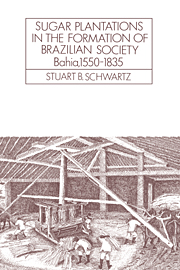Book contents
- Frontmatter
- Contents
- List of figures, maps, and tables
- Preface
- Abbreviations and special terms
- Weights and measures
- Dedication
- Part I Formations, 1500–1600
- Part II The Bahian engenhos and their world
- 4 The Recôncavo
- 5 Safra: the ways of sugar making
- 6 Workers in the cane, workers at the mill
- 7 The Bahian sugar trade to 1750
- 8 A noble business: profits and costs
- Part III Sugar society
- Part IV Reorientation and persistence, 1750–1835
- Appendixes
- Notes
- Glossary
- Sources and selected bibliography
- Sources of figures
- Index
- CAMBRIDGE LATIN AMERICAN STUDIES IN PRINT
8 - A noble business: profits and costs
Published online by Cambridge University Press: 05 May 2010
- Frontmatter
- Contents
- List of figures, maps, and tables
- Preface
- Abbreviations and special terms
- Weights and measures
- Dedication
- Part I Formations, 1500–1600
- Part II The Bahian engenhos and their world
- 4 The Recôncavo
- 5 Safra: the ways of sugar making
- 6 Workers in the cane, workers at the mill
- 7 The Bahian sugar trade to 1750
- 8 A noble business: profits and costs
- Part III Sugar society
- Part IV Reorientation and persistence, 1750–1835
- Appendixes
- Notes
- Glossary
- Sources and selected bibliography
- Sources of figures
- Index
- CAMBRIDGE LATIN AMERICAN STUDIES IN PRINT
Summary
The farming, preparation, and planting of the sweet and domestic canes from which sugar is made is the most onerous and costly activity that has been discovered on earth, and the most difficult, and at the same time, the most ingenious … in no way can one begin without a great and considerable expense, in starting and in the infallible replacements in every aspect.
Discurso preliminar (ca. 1789)Whatever the social and political privileges or status associated with plantership and slaveowning, and we shall see that these were considerable, the business of sugar making was just that, a business. Engenhos and their associated canefields were operated as enterprises, responsive to gain and loss and sensitive to the vagaries of the marketplace. The essential questions we must ask are those the planters asked themselves: What did it cost to set up a sugar mill? From whom could the initial capital be obtained? What was the proper and most profitable mix of productive factors? What did it cost to operate each year, and what was the return on investment? These seem to be rather simple queries, matters of simple accounting, but herein lies the problem. The material needed to answer many of these questions does not exist. Individual estate records are, with a few notable exceptions, lacking. Notarial registers, though more numerous, are scattered, fragmentary, and often silent on important issues. Finally, as a general problem, accounting practices in the period under study consistently mixed current expenses with capital-stock purchases.
- Type
- Chapter
- Information
- Sugar Plantations in the Formation of Brazilian SocietyBahia, 1550–1835, pp. 202 - 242Publisher: Cambridge University PressPrint publication year: 1986



